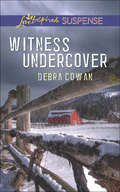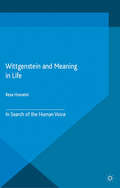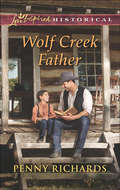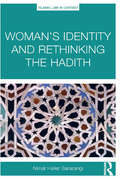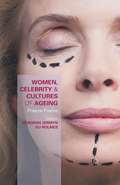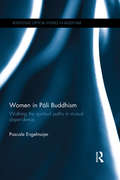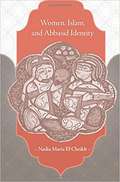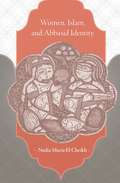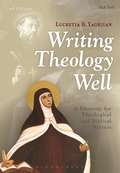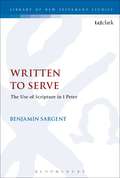- Table View
- List View
Witness Undercover: Explosive Alliance Witness Undercover Into Thin Air (Mills And Boon Love Inspired Suspense Ser.)
by Debra CowanIN SAFE KEEPING
Wittgenstein and Meaning in Life: In Search of the Human Voice
by R. HosseiniWhat could Wittgenstein's work contribute to the rapidly growing literature on life's meaning? This book not only examines Wittgenstein's scattered remarks about value and 'sense of life' but also argues that his philosophy and 'way of seeing' has far reaching implications for the ways theorists approach an ancient question: 'How shall one live?'.
Wolf Creek Father: Wolf Creek Father Cowboy Seeks A Bride Falling For The Enemy Accidental Fiancee (Mills And Boon Love Inspired Historical Ser.)
by Penny RichardsA Wife for the Sheriff?
Wolf Creek Widow: Wolf Creek Widow His Precious Inheritance A Home For His Family The Matchmaker's Match (Mills And Boon Love Inspired Historical Ser.)
by Penny RichardsThe Widow's Second Chance
Woman's Identity and Rethinking the Hadith (Islamic Law in Context #1)
by Nimat Hafez BarazangiThe Prophet Muhammad’s reported traditions have evolved significantly to affect the social, cultural, and political lives of all Muslims. Though centuries of scholarship were spent on the authentication and trustworthiness of the narrators, there has been less study focused on the contents of these narratives, known as Hadith or Sunnah, and their corroboration by the Qur`an. This book is a first step in a comprehensive attempt to contrast Hadith with the Qur`an in order to uncover some of the unjust practices by Muslims concerning women and gender issues. Using specific examples the author helps the reader appreciate and understand the magnitude of the problem. It is argued that the human rights and the human development of Muslim women will not progress in a meaningful and sustainable manner until the Hadith is re-examined in a fresh new approach from within the Islamic framework, shifting the discourse in understanding Islam from a dogmatic religious law to a religio-moral rational worldview. The author argues that such re-examination requires the involvement of women in order to affirm their authority in exegetical and practical leadership within Muslim societies, and she encourages Muslim women to stand up for their rights to effect change in understanding the role of sunnah in their own life.
Woman's Identity and Rethinking the Hadith (Islamic Law in Context #1)
by Nimat Hafez BarazangiThe Prophet Muhammad’s reported traditions have evolved significantly to affect the social, cultural, and political lives of all Muslims. Though centuries of scholarship were spent on the authentication and trustworthiness of the narrators, there has been less study focused on the contents of these narratives, known as Hadith or Sunnah, and their corroboration by the Qur`an. This book is a first step in a comprehensive attempt to contrast Hadith with the Qur`an in order to uncover some of the unjust practices by Muslims concerning women and gender issues. Using specific examples the author helps the reader appreciate and understand the magnitude of the problem. It is argued that the human rights and the human development of Muslim women will not progress in a meaningful and sustainable manner until the Hadith is re-examined in a fresh new approach from within the Islamic framework, shifting the discourse in understanding Islam from a dogmatic religious law to a religio-moral rational worldview. The author argues that such re-examination requires the involvement of women in order to affirm their authority in exegetical and practical leadership within Muslim societies, and she encourages Muslim women to stand up for their rights to effect change in understanding the role of sunnah in their own life.
Women and Pilgrimage in Medieval Galicia
by Carlos Andrés González-PazFor many in the Middle Ages, pilgrimages were seen to represent a clear risk of moral and religious perdition for women, and they were strongly discouraged from making them; this exhortation would have been universally disseminated and generally followed, except, of course, in the case of the virtuous ’extraordinary women’, such as saints and queens. Women and Pilgrimage in Medieval Galicia represents an analysis of the social history of women based on documentary sources and physical evidence, breaking away from literary and historiographical stereotypes, while at the same time contributing to a critical assessment of the myth that medieval women were kept hidden away from the world. As the chapters here show, women - and not only those ’extraordinary women’, but also women from other social strata - became pilgrims and travelled the paths that led from their homes to the most important Christian shrines, especially - although not exclusively - Jerusalem, Rome and Santiago de Compostela. It can be seen that medieval women were actively involved in this ritualistic expression of devotion, piety, sacrifice or penitence. This situation is thoroughly documented in this multidisciplinary book, with emphasis both on the pilgrimages abroad from Galicia and on the pilgrimages to the shrine of St James at Compostela.
Women and Pilgrimage in Medieval Galicia
by Carlos Andrés González-PazFor many in the Middle Ages, pilgrimages were seen to represent a clear risk of moral and religious perdition for women, and they were strongly discouraged from making them; this exhortation would have been universally disseminated and generally followed, except, of course, in the case of the virtuous ’extraordinary women’, such as saints and queens. Women and Pilgrimage in Medieval Galicia represents an analysis of the social history of women based on documentary sources and physical evidence, breaking away from literary and historiographical stereotypes, while at the same time contributing to a critical assessment of the myth that medieval women were kept hidden away from the world. As the chapters here show, women - and not only those ’extraordinary women’, but also women from other social strata - became pilgrims and travelled the paths that led from their homes to the most important Christian shrines, especially - although not exclusively - Jerusalem, Rome and Santiago de Compostela. It can be seen that medieval women were actively involved in this ritualistic expression of devotion, piety, sacrifice or penitence. This situation is thoroughly documented in this multidisciplinary book, with emphasis both on the pilgrimages abroad from Galicia and on the pilgrimages to the shrine of St James at Compostela.
Women and the Messianic Heresy of Sabbatai Zevi, 1666 - 1816 (The Littman Library of Jewish Civilization)
by Ada Rapoport-AlbertWomen are conspicuously absent from the Jewish mystical tradition. Even if historically some Jewish women may have experienced mystical revelations and led richly productive spiritual lives, the tradition does not preserve any record of their experiences or insights. Only the chance survival of scant evidence suggests that, at various times and places, individual Jewish women did pursue the path of mystical piety or prophetic spirituality, but it appears that they were generally censured, and efforts were made to suppress their activities. This contrasts sharply with the fully acknowledged prominence of women in the mystical traditions of both Christianity and Islam. It is against this background that the mystical messianic movement centred on the personality of Sabbatai Zevi (1626 - 76) stands out as a unique and remarkable exception. Sabbatai Zevi addressed to women a highly original liberationist message, proclaiming that he had come to make them 'as happy as men' by releasing them from the pangs of childbirth and the subjugation to their husbands that were ordained for women as a consequence of the primordial sin. This unprecedented redemptive vision became an integral part of Sabbatian eschatology, which the messianists believed to be unfolding and experienced in the present. Their New Law, superseding the Old with the dawning of the messianic era, overturned the traditional halakhic norms that distinguished and regulated relations between the sexes. This was expressed not only in the outlandish ritual transgression of sexual prohibitions, in which Sabbatian women were notoriously implicated, but also in the apparent adoption of the idea - alien to rabbinic Judaism - that virginity, celibacy, or sexual abstinence were conducive to women's spiritual empowerment. Ada Rapoport-Albert traces the diverse manifestations of this vision in every phase of Sabbatianism and its offshoots. These include the early promotion of women to centre-stage as messianic prophetesses; their independent affiliation with the movement in their own right; their initiation in the esoteric teachings of the kabbalah; and their full incorporation, on a par with men, into the ritual and devotional life of the messianic community. Their investment with authority was such as to elevate the messiah's wife (a figure mostly absent from traditional messianic speculations) to the rank of full messianic consort, sharing in her husband's redemptive mission as well as his divine dimension. By the late eighteenth century, a syncretistic cult had developed that recognized in Eva - the unmarried daughter of Jacob Frank, one of Sabbatai Zevi's apostate messianic successors - an incarnate female aspect of the kabbalistic godhead, worshipped by her father's devotees as 'Holy Virgin' and female messiah. This was the culmination of the Sabbatian endeavour to transcend the traditional gender paradigm that had excluded women from the public arena of Jewish spiritual life. This work is translated by Deborah Greniman.
Women, Celebrity and Cultures of Ageing: Freeze Frame
by Deborah Jermyn Su HolmesThis book studies the relationship between women, ageing and celebrity. Focusing on an array of case studies and star/celebrity images, it aims to examine the powerful, contradictory and sometimes celebratory ways in which celebrity culture offers a crucial site for the contemporary and historical construction of discourses on ageing femininities.
Women in Pāli Buddhism: Walking the Spiritual Paths in Mutual Dependence (Routledge Critical Studies in Buddhism)
by Pascale EngelmajerThe Pāli tradition presents a diverse and often contradictory picture of women. This book examines women’s roles as they are described in the Pāli canon and its commentaries. Taking into consideration the wider socio-religious context and drawing from early brahmanical literature and epigraphical findings, it contrasts these descriptions with the doctrinal account of women’s spiritual abilities. The book explores gender in the Pāli texts in order to delineate what it means to be a woman both in the context in which the texts were composed and in the context of their ultimate goal - that of achieving escape from the round of rebirths. The critical investigation focuses on the internal relationships and dynamics of one tradition and employs a novel methodology, which the author calls "critical sympathy". This assumes that the tradition’s teaching is valid for all, in particular that its main goal, nibbāṇa, is accessible to all human beings. By considering whether and how women’s roles fit within this path, the author examines whether women have spiritual agency not only as bhikkhunīs (Buddhist nuns), but also as wives and mothers. It offers a new understanding that focuses on how the tradition construes women’s traditional roles within an interdependent community. It aims to understand how what many scholars have seen as contradictory and inconsistent characterizations of women in Buddhism have been accepted and endorsed by the Pāli tradition. With an aim to show that the Pāli canon offers an account of women that is doctrinally coherent and consistent with its sociological facts, this book will be of interest to students and scholars of Buddhism and Asian Religion.
Women in Pāli Buddhism: Walking the Spiritual Paths in Mutual Dependence (Routledge Critical Studies in Buddhism)
by Pascale EngelmajerThe Pāli tradition presents a diverse and often contradictory picture of women. This book examines women’s roles as they are described in the Pāli canon and its commentaries. Taking into consideration the wider socio-religious context and drawing from early brahmanical literature and epigraphical findings, it contrasts these descriptions with the doctrinal account of women’s spiritual abilities. The book explores gender in the Pāli texts in order to delineate what it means to be a woman both in the context in which the texts were composed and in the context of their ultimate goal - that of achieving escape from the round of rebirths. The critical investigation focuses on the internal relationships and dynamics of one tradition and employs a novel methodology, which the author calls "critical sympathy". This assumes that the tradition’s teaching is valid for all, in particular that its main goal, nibbāṇa, is accessible to all human beings. By considering whether and how women’s roles fit within this path, the author examines whether women have spiritual agency not only as bhikkhunīs (Buddhist nuns), but also as wives and mothers. It offers a new understanding that focuses on how the tradition construes women’s traditional roles within an interdependent community. It aims to understand how what many scholars have seen as contradictory and inconsistent characterizations of women in Buddhism have been accepted and endorsed by the Pāli tradition. With an aim to show that the Pāli canon offers an account of women that is doctrinally coherent and consistent with its sociological facts, this book will be of interest to students and scholars of Buddhism and Asian Religion.
Women in Sufism: Female Religiosities in a Transnational Order (Routledge Sufi Series)
by Marta Dominguez DiazExploring the diverse myriad of female religious identities that exist within the various branches of the Moroccan Sufi Order, Qādiriyya Būdshīshiyya, today, this book evidences a wide array of religious identities, from those more typical of Berber culture, to those characterised by a ‘sober’ approach to Sufism, as well as those that denote New Age eclecticism. The book researches the ways in which religious discourses are corporeally endorsed. After providing an overview of the Order historically and today, enunciating the processes by which this local tarīqa from North-eastern Morocco has become the international organization that it is now, the book explores the religious body in movement, in performance, and in relation to the social order. It analyses pilgrimage by assessing the annual visit that followers of Hamza Būdshīsh make to the central lodge of the Order in Madāgh; it explores bodily religious enactments in ritual performance, by discussing the central practices of Sufi ritual as manifested in the Būdshīshiyya, and delves attention into diverse understandings of faith healing and health issues. Women and Sufism provides a detailed insight into religious healing, sufi rituals and sufi pilgrimage, and is essential reading for those seeking to understand Islam in Morocco, or those with an interest in Anthropology and Middle East studies more generally.
Women in Sufism: Female Religiosities in a Transnational Order (Routledge Sufi Series)
by Marta Dominguez DiazExploring the diverse myriad of female religious identities that exist within the various branches of the Moroccan Sufi Order, Qādiriyya Būdshīshiyya, today, this book evidences a wide array of religious identities, from those more typical of Berber culture, to those characterised by a ‘sober’ approach to Sufism, as well as those that denote New Age eclecticism. The book researches the ways in which religious discourses are corporeally endorsed. After providing an overview of the Order historically and today, enunciating the processes by which this local tarīqa from North-eastern Morocco has become the international organization that it is now, the book explores the religious body in movement, in performance, and in relation to the social order. It analyses pilgrimage by assessing the annual visit that followers of Hamza Būdshīsh make to the central lodge of the Order in Madāgh; it explores bodily religious enactments in ritual performance, by discussing the central practices of Sufi ritual as manifested in the Būdshīshiyya, and delves attention into diverse understandings of faith healing and health issues. Women and Sufism provides a detailed insight into religious healing, sufi rituals and sufi pilgrimage, and is essential reading for those seeking to understand Islam in Morocco, or those with an interest in Anthropology and Middle East studies more generally.
Women, Islam, and Abbasid Identity
by Nadia Maria El CheikhWhen the Abbasids overthrew the Umayyads in 750 CE and ushered in Islam’s Golden Age, ideas about gender and sexuality were central to the process by which the caliphate achieved self-definition and articulated its systems of power and thought. Nadia Maria El Cheikh’s study reveals the importance of women to the writing of early Islamic history.
Women, Islam, and Abbasid Identity
by Nadia Maria El CheikhWhen the Abbasids overthrew the Umayyads in 750 CE and ushered in Islam’s Golden Age, ideas about gender and sexuality were central to the process by which the caliphate achieved self-definition and articulated its systems of power and thought. Nadia Maria El Cheikh’s study reveals the importance of women to the writing of early Islamic history.
Women's Bodies as Battlefield: Christian Theology and the Global War on Women
by Susan Brooks ThistlethwaiteChristian theology has been complicit in justifying the war on women, but it also has resources to help finally declare peace in the war on women. War itself has come to resemble the war on women, and thus strategies to end the war on women, supported by new Christian theological interpretations, will also help end today's endless wars.
Women's Cricket and Global Processes: The Emergence and Development of Women's Cricket as a Global Game
by Philippa VelijaHow can the diffusion and development of women's cricket as a global sport be explained? Women 's Cricket and Global Processes considers the emergence and growth of women's cricket around the world and seeks to provide a sociological explanation for how and why the women's game has developed the way it has.
Women’s Employment in Muslim Countries: Patterns of Diversity
by Niels SpieringsThis book presents a new and nuanced exploration of the position of women in Muslim countries, based on research involving more than 300,000 women in 28 Muslim countries. It addresses topical debates on the role of Islam, modernization, globalization, neocolonialism, educational inequalities, patriarchy, household hierarchies, and more.
Women's Religious Experience (Routledge Library Editions: Women and Religion)
by Pat HoldenMost of the early literature concerning women’s religious experience is about exceptional women; those who diverged from the traditional female role to become nuns, mystics or charismatic leaders. While women were permitted to be prophets and visionaries they rarely played an important part in church organisation. This paradox is explored in this book and a number of themes emerge: in particular, the dominance of male symbolism within the great religions. The question of whether men and women apprehend religious systems and signs in the same way is also explored. In considering the contemporary scene, the book is able to look at the ways in which religion affects the lives of women in different societies and in different historical periods; this gives us a larger view of the ways in which our own perceptions of ‘femaleness’ have been constructed out of the religious world views of both the past and the present. First Published in 1983.
Women's Religious Experience (Routledge Library Editions: Women and Religion)
by Pat HoldenMost of the early literature concerning women’s religious experience is about exceptional women; those who diverged from the traditional female role to become nuns, mystics or charismatic leaders. While women were permitted to be prophets and visionaries they rarely played an important part in church organisation. This paradox is explored in this book and a number of themes emerge: in particular, the dominance of male symbolism within the great religions. The question of whether men and women apprehend religious systems and signs in the same way is also explored. In considering the contemporary scene, the book is able to look at the ways in which religion affects the lives of women in different societies and in different historical periods; this gives us a larger view of the ways in which our own perceptions of ‘femaleness’ have been constructed out of the religious world views of both the past and the present. First Published in 1983.
The Word Hesed in the Hebrew Bible (The Library of Hebrew Bible/Old Testament Studies)
by Gordon R. ClarkThis impressive semantic study, with a useful glossary of special and technical terms, develops an original methodology, bringing new insights into the meaning of a much-discussed word. Working with an immense amount of data, obtained by examining every occurrence in the Hebrew Bible of 35 field elements, the author achieves a new degree of semantic refinement based on meticulous quantitative analysis of distribution, collocations, parallels and syntagms. Sense-relations are formulated between hesed and other related terms. This study provides much material for a better understanding of this crucial term for Hebrew thought, and also makes an important theoretical contribution to Hebrew lexicography.
Would-Be Wilderness Wife: Would-be Wilderness Wife Hill Country Courtship The Texan's Inherited Family The Daddy List (Frontier Bachelors #2)
by Regina ScottThe Kidnapped Bride
Writing Theology Well 2nd Edition: A Rhetoric for Theological and Biblical Writers
by Lucretia B. YaghjianA working guide for students conducting theological writing and research on theology and biblical studies courses, this book integrates the disciplines of writing, rhetoric, and theology, to provide a standard text for the teaching and mentoring of writing across the theological curriculum.As a theological rhetoric, it also encourages excellence in theological writing in the public domain by helping to equip students for their wider vocations as writers, preachers, and communicators in a variety of ministerial and professional contexts. This 2nd Edition includes new chapters on 'Writing Theology in a New Language', which explores the linguistic and cultural challenges of writing theology well in a non-native language, and 'Writing and Learning Theology in an Electronic Age', addressed to distance learning students learning to write theology well from online courses, and dealing with the technologies necessary to do so.
Written To Serve: The Use of Scripture in 1 Peter (The Library of New Testament Studies #547)
by Benjamin SargentThe use of Scripture in 1 Peter has been subject to much extensive analysis in the last thirty years. In Written to Serve Benjamin Sargent offers an up to date and comprehensive analysis of how 1 Pet 1.10-12 offers a 'hermeneutic,' providing an insight into how Scripture is interpreted in the letter. Sargent also argues that the relation of 1.10-12 has been misunderstood. Rather than offering a Christological hermeneutic with a focus on the suffering and glories of Christ, Sargent asserts that the primary importance of 1.10-12 is its orientation of the prophetic witness towards the eschatological community as an act of service. Similarly, rather than offering a theological narrative of continuity between Israel and Christian communities, 1.10-12 may be seen to suggest a narrative of profound discontinuity in which the community in the present is elevated above God's people of the past.
